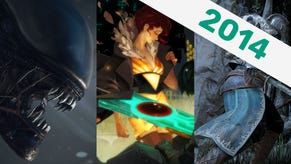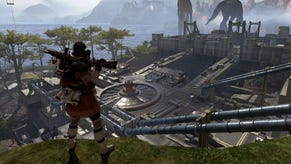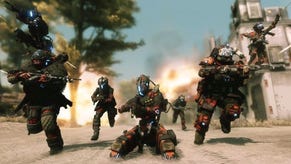Wot I Think: Titanfall
Gulf Of Oh Man
Update: In light of recent changes to the game, which have made Capture the Flag mode playable only via a randomised "Variety" mode and in Private Matches, I retract much of what caused me to recommend the game below. See more here.
Titanfall is a first-person shooter with a story but no singleplayer mode. That means that if you play its nine campaign maps through, no NPC ever calls you by name as they remind you to reload, no dastardly villain ever traps you in a small container and takes away your weapons, and no scripted sidekick ever makes an awkward joke about why you never speak. Its story and its characters play out as radio plays, picture-in-picture talking heads, and brief pre- and post-mission cutscenes, but in each you're treated as just another anonymous soldier. You exist only to be shoved out of a dropship in order to fight in brief, 15-minute matches of what are, essentially, dressed-up versions of six vs. six team deathmatch and capture-and-hold modes.
This is a great thing. Freed from the anxious need to convince you that you're special, Titanfall instead builds a set of systems within which heroism and glory occur naturally. There is no "Titan level" akin to Battlefield's brief jet sections; there is instead the ability, every two minutes, to summon your own robot buddy from orbit. There is no running up to a door and waiting like a patient dog while an NPC master runs over to open it for you; there is instead the ability to overcome any obstacle with wall-running and double-jumping, and the opportunity to skillfully chain those moves together into swift, balletic combat.
There is, instead, a whole different set of problems to complain about. This is Wot I Think.
You're maybe doing a little maths in your head right now. If there are only nine campaign maps, and each only takes around 15-minutes to play - sometimes less - doesn't that make Titanfall extremely short? Yes, it does. You can play through its campaign in around 90 minutes, and while you then have the opportunity to play it a second time as the opposing side, there's no forks in the road or changes in outcome to discover, whether your team loses every round or wins every round. Whatever you do during its matches, your killing, dying, capturing, holding, obviously aren't vital to the fight the story is about.
Similarly, the campaign isn't vital to your enjoyment of the game. The story, which is about futuristic spaceships, distant worlds, some corporate guys who are dicks, some freedom-loving guys who I guess probably aren't such large dicks, and who are led by a former corporate guy and, look, I've played it through more than once and I still don't care. It's a thin, unobtrusive excuse to fill levels with smashed machinery, orbital lasers, and for some reason dinosaurs.
The best way to run around amidst those excused scifi elements and dinosaurs is instead in the game's capture the flag mode. Which I would not have guessed in advance. Titanfall turns out not to be so much a game about fighting robots or a daring merging of singleplayer and multiplayer. Instead it's a Capture The Flag game where every soldier is a parkour expert, and where leaping onto the backs and into the bellies of mechs is just another part of your movement set, alongside leaping through windows and clambering on top of buildings.
Capture The Flag is the best way to experience that skillset, because it's the mode that puts the most demands on the precision and speed of a player's movement. Grabbing the flag causes you to appear as a HUD icon to every player on the server, meaning you're a suddenly visible target for every other pilot and robot in the vicinity. The first thing you'll want to do is get high, to where Titans can't follow. It's only ever a hop, skip and a leap to the nearest rooftop, and from there you need never touch the ground again.
This creates moments of system-created heroism. I prefer to play defense, but as I sat in my mech, firing rockets and missing a fleeing flag carrier as she sprinted along the side of a tubular glass corridor, I couldn't help but picture how the set-up appeared from her perspective. She was briefly the player-character of an action set-piece designed around her, my inaccurate shots lighting her heels.
Sitting inside your mech is the most obvious way to interact with your robot pal, but the speed and agility and gleeful fun of leaping around means I far prefer remaining on foot. I deploy my Titan instead as a battlefield assistant. There is a map - I don't know its name, for reasons I'll explain later - in which a large, central warehouse divides the level, and smaller buildings, crates and walls litter routes towards each team's flag.
I like to fight a little, till my Titan is ready, then set my ro-bro to Guard mode next to the flag while I double-jump-wall-run my way to the top of the warehouse. From there I sit with a sniper rifle trained back towards the flag. If any opponent arrives in their own robot, my mech is waiting and will scrap without my involvement. If an enemy arrives on foot, my robot will engage them and I get the points for anyone it kills. If anyone is quick enough to get away, there's a long courtyard for them to traverse and for me to train my sniper sights upon them.
This is just one instance in which Titans feel like the best possible teammate. On tighter maps, I switch to a shotgun, pop my Titan on follow mode and we move across the level as a unit. While he watches the streets, I hop in windows and across rooftops. If we meet an enemy Titan, my buddy causes enough of a distraction that I can rodeo on top of his opponent, open a compartment, and fire directly into its metal brain. If we meet a pilot on foot, even if I die, there's a chance my Titan will avenge me and still be waiting when I respawn. If occasionally he would flip me a giant piece of spare change, I'd like my Titan more than I do BioShock Infinite's Elizabeth.
I wrote in my beta impressions post that I was surprised and impressed that piloting Titans didn't feel like a separate game detached from the ground combat, and that's still true. Titans are a tactical consideration, as core to whatever plan you're forming as the weapon in your hand. They're also moving level geometry. I've spent a lifetime glitchily, laggily balancing myself on top of friendly plane wings and jeep bonnets in various multiplayer games; I rarely hitch a ride on the back of a teammate's Titan, but it's so important that I can if I want to and that it just works.
Even with familiar game modes and familiar weapons, every part of Titanfall just works, clicking together in ways impressive enough to rise far above any dull, cynical dismissal of the game as 'Call of Duty with robots'.
I say all this in spite of being someone who dies a lot. This seems worth stating. I like to measure games by the skill and finesse they allow within their systems, but also by how fun they are if you're incapable of either. There was a moment yesterday in which I grabbed an opposing team's flag and, in the same instant, pointed to a distant spot and summoned my Titan to land there from orbit. I double-jumped through a window and again on to a rooftop, before wall-running along a provided metal sheet to pick up enough speed that my next jump took me over to a higher, adjacent building. As I leapt off the other side, my Titan thumped down, caught me in mid-air and tucked me inside its tummy. From there, I crossed the map, strode into combat with a waiting posse of enemy robots, used the rocketing eject button to blast myself into the sky, and steered my descent back to earth towards my own team's flag and my first capture point.
In another moment yesterday, I moved to leap from a window, caught the sill instead and wall-ran 180-degrees around to face the room I was trying to leave. I then reflexively double-jumped and landed on top of the ceiling's light fixtures.
I've raved in over half of all my RPS posts about the importance of movement being fun in first-person shooters, and of how much I love skiing in Tribes. Truthfully though, I'm not very good at skiing either, and there's always a point where I bounce off a rock and all my momentum dribbles away. At that point I'm just jogging along, hoping the next slope comes soon.
That's not an issue in Titanfall. At this stage, I feel like I'm repeating those early scenes in a superhero movie in which Spider-Man or Iron Man first learns to use their powers. My rocket boosters are punting me erratically around the room, or I'm falling inertly from a rooftop, but there's never any point where I'm not having fun.
I sort of wish I could just stop writing there. As a game, as a piece of design, as a set of systems which coalesce and entwine in clever, remarkable, original ways, Titanfall is fun to play and fun to write about. I'm going to keep playing it. I hope lots of other people play it.
Except, the reason I don't know the names of any of the maps is that you can't ever select which map you want to play. You pick "Classic", then what game mode, and the matchmaking places you and whoever else is in your lobby together in a match you can't customise.
There are no dedicated servers of any kind. There is no support for establishing or maintaining clans. There will never be any mods. Titanfall is currently £45 from Origin (£33 from Amazon in a box), with a £20 season pass available for unannounced future DLC. That DLC will probably consist of sets of map packs and, if Call of Duty and Battlefield are anything to go by, each one will split the multiplayer community between the haves and have nots.
You should always judge a game by what it is and not by what it's not, but there's a gulf between the way in which I want to interact with mulitplayer first-person shooters and the manner in which Titanfall has been provided. It won't stop me playing, but it might stop me playing for as long. That's a shame.























